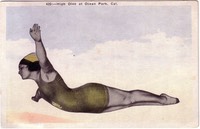John Gunther Inside U.S.A., Harper & Brothers: New York and London, 1947, 979 pp.
Southern California, the third of the state below the Tehachapi, is something else again; it has a mood and character absolutely different from the north, so much so that it is practically a different commonwealth. This is the California of petroleum, every religious cults [sic KR], the citrus industry, towns based on rich rentiers like Santa Barbara and Pasadena, the movies, the architecture in the United States, refugees from Iowa, a steeply growing Negro population and devotees of funny money. It is, above all, the world where climate is worshipped as a god. “The most valuable ingredient of the California way of life, sunshine, is free,” as Life once wrote. Yet all southern California would shrivel and disappear—almost overnight—if it were not for imported water. Everything depends on irrigation, i.e. artificial rain. The “rain” comes by pipe and canal.
I began this section by saying that the population of California was “around” eight and a half million. There is a reason for this lapse into [p. 5] the a`peu pres, namely that no one knows what the exact figure is. In 1940 it was 6,907,387. But with the war—as we all know—came a tremendous influx not merely of military personnel but of defense workers and their families. By 1943 the population was estimated at 8,373,800 and by 1944 at 8,842,700; today it is probably about the same, though some estimates go as high as 9,200,000. Conservatively, it is agreed by all authorities that in five years the state has gained at least 1,500,000 people, an increase of 22.4 per cent.
Some astonishing details are released if we break these figures down. For instance, San Diego jumped from a population of 203,341 in 1940 to an estimated 362,658 in 1946—a rise of not less than 78 per cent. The San Francisco area rose from 1,461,800 to 1,840,500 (26 per cent), and Los Angeles County from 2,916,400 to 3,357,000 (15 per cent). Los Angeles is today the fourth largest city in the country. Some single counties in the Bay region—more than doubled their population in the war period; they rose 100 per cent or more. This prodigious increase came, moreover, atop other increases; for instance, the population of the state rose 65 per cent in the years from 1920 to 1930, and it is entirely possible, even probable, that within the next few decades it will surpass New York and Pennsylvania to become the most populous in the union.
The median age in California is, incidently, thirty-three. This compares to twenty-nine for the United States as a whole and twenty-three in the “youngest” state, New Mexico. The reason for this is, of course the great number of old folks who have poured in from the Middle West; most Californians today are not, as is well known, California born. Another population figure is that about one-ninth of the people of the state are foreign born. To an outsider, this figure may seem high and striking; actually—as we shall presently see in connection with other states—it is comparatively low.
Most of the war workers who entered California from 1940 to 1945 went into two extremely volatile industries, aircraft and shipbuilding; hence the issue of reconversion was more than normally acute. Beyond this, the influx produced other problems, for instance the fact that no one can guess how California will vote next time. Again shall the state attempt to get rid of the new “in-migrants,” as some people wish, and if so, how; if not, how will it possibly find jobs and residence for them all? The housing problem in the state is, as everywhere, anguishing. Most responsible Californians hope that the new arrivals will stay and find jobs and a place to live; out of a new melting pot they hope to absorb new strength; the motto is, “Don’t talk reconversion, but convert instead.”
California ia so celebrated for Central Valley and its agriculture—avocadoes, melons, spinach, asparagrus, grapefruit, olives, what not—that one is tempted to think of it as predominantly rural. This is not true [p. 6] from the population point of view, even though agriculture (and associated industries like canning) support more people than any other industry. But California is an urban state, not rural; even Los Angeles County is an urban area. The simplest of statistics tells the story. About 80 per cent of the total population lives in cities and metropolitan areas; not less than 5,200,000, over half the total number of people in the state, are clustered around Los Angeles and San Francisco alone.
